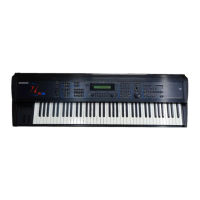Chapter 1ÑWelcome
ENSONIQ ZR-76 Musician's Manual 13
You can add new sounds to your ZR-76 by purchasing ENSONIQ ZRD Series Sound Disks. You may also
install ENSONIQ EXP Series Wave Expansion Boards, which provide completely new sound waves, and
sounds based on them. Additional sounds that take advantage of expansion board waves can be obtained
through the purchase of ENSONIQÕs EXD Series Disks.
In SoundFinder, you can use any sounds to easily create:
¥ splitsÑwhere one sound is heard in the lower part of the keyboard and a different sound is heard in
the upper part
¥ layersÑwhere two sounds are heard stacked on top of each other
¥ combination split/layersÑwhere the lower part of the keyboard plays the split sound, and the upper
area contains two sounds layered on top of each other
Each of these combinations can be saved as a presetÑan ideal tool for performanceÑor as a single sound
that can be used for recording in the ZR-76.
SoundFinder is more than just an area on the front panel of your ZR-76. ItÕs an incredibly simple-to-use
method for finding the sounds you want. Computer users may be familiar with databases, which allow you
to view information in a manner of your choosing. SoundFinder operates in much the same way. Your ZR-
76 keeps a list of all the sounds available to it at any given time, and shows them to you in logical,
musically convenient categories called sound types.
Sound types show you sounds by instrument familyÑVOCALS or BELLS, for exampleÑor by a number of
other useful criteria, including the location in the ZR's memory where they reside. The ALL-SND category is
especially useful, since it shows all of the ZR's sounds arranged in alphabetical order. The *CUSTOM and
USER-SND categories can be used for storing your own sounds.
If you know the name of the sound youÕre looking for, you can hold down SoundFinderÕs Select Sound
button and spell the soundÕs name using the ZR's keyboard. Each key has been assigned a number or
letter, which is printed above the key. SoundFinder will retrieve the sound you want.
Any sound you select in SoundFinder can be sent to the ZRÕs 16 Track Recorder when it comes time to
develop one of your musical ideas.
The SoundFinder section also unlocks the ZRÕs power as a MIDI keyboard for performance. By setting a
SoundFinder sound, split and/or layer to transmit MIDI, your keyboard can be turned into a three-way
MIDI master controller.
Any sound in SoundFinder can also be selected via MIDI. The sounds are arranged inside the ZR-76 in
groupings called banks. Each bank corresponds to a MIDI Bank Select number, and each sound has its
own MIDI program change.
Sounds, SoundFinder and the customization of sounds are all discussed fully in Chapter 4ÑSoundFinder.
DD
DD
rr
rr
uu
uu
mm
mm
MM
MM
aa
aa
cc
cc
hh
hh
ii
ii
nn
nn
ee
ee
The ZR-76 Drum Machine provides highly realistic rhythmic accompaniment for music-making in a wide
variety of styles. Simple to operate, yet packed with editing options, the Drum Machine is perfect for
playing along with in performance, for fun, or while searching for new song ideas.
To operate the Drum Machine, all you need to do is select a rhythm and hit the Start button. The Drum
Machine has its own version of SoundFinderÑcall it RhythmFinder, if you will. Rhythms are divided into
categories that can be selected with the Sound/Rhythm Type knob. The Sound/Rhythm Name knob
chooses individual rhythms from within the selected category. Additional rhythms are available on
ENSONIQÕs ZRD Series Sound Disks.
Each Drum Machine rhythm contains eight variations of the same musical style, as well as eight drum fills
for providing musical punctuation to your beats. Just about everything in a rhythm is customizable: you
can change the drum or percussion kit used by a rhythm, alter the sounds in the kit, or change what each
variation or fill plays. You can change a rhythmÕs tempo by tapping on the Drum MachineÕs Tempo button,
or by dialing it in manually. You can even swap musical phrases between one rhythm and another to
assemble your own rhythms, which can be stored in your ZRÕs memory, and on floppy disk for safekeeping.
You can also save a collection of rhythms to floppy as a rhythm bank. If youÕve got a PC-compatible
computer, you can make your own rhythms using the RhythmBuilder utility you can find at ENSONIQÕs
World Wide Web site at http://www.ensoniq.com.
You can send a Drum Machine rhythm to the 16 Track Recorder, for use as a rhythm track for your music.
The Drum Machine is discussed fully in Chapter 5ÑThe Drum Machine.

